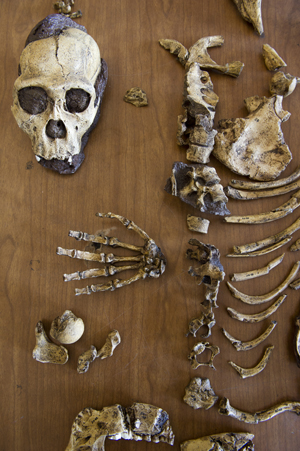They say that to understand another person, you must walk in her shoes. Jeremy DeSilva took that advice to the extreme, attempting to understand a prehistoric ancestor by walking in her feet.
It hurt: putting his foot down on its outer edge, then rolling it inward, step by excruciating step. “It is painful,” says DeSilva, who ambulated (or, more scientifically, hyperpronated) around campus, and occasionally still does. He believes that’s how Australopithecus sediba got around two million years ago, with an anatomy, unlike ours, suited to such a peculiar gait. The South African protoperson, a mixed bag of human and ape traits, could walk upright and also clamber up trees.
DeSilva, a College of Arts & Sciences assistant professor of anthropology, was lead writer on one of six papers published last April in the journal Science, describing in loving detail how this hybrid hominid—a woman, four- to four-and-a-half-feet tall, whose skeletal remains were excavated in South Africa by a team led by paleoanthropologist Lee Berger of the University of the Witwatersrand—got around.
A coauthor, physical therapy specialist Kenneth Holt, a Sargent College associate professor, helped DeSilva deduce A. sediba’s walk in a serendipitous collaboration that DeSilva says “doesn’t happen enough” in science.
In 2011, Holt went to a talk his one-time student DeSilva gave at BU about A. sediba, whose remains were discovered in 2008, part of a momentous cache that included a pair of complete skeletons and partial remains of at least three others. (“To get a skeleton is incredibly rare,” says DeSilva. “They’ve got two.”) DeSilva, who was part of the select team that studied the fossils, confessed in his talk that he was stumped by the female creature’s anatomy: it appeared she had the ability to walk and climb, but her oddly shaped foot and knee prevented a comprehensive understanding of exactly how she walked. “It was nothing like any early human I’d ever seen,” he says.

Australopithecus sediba was a mixed bag of human and ape traits. The backbones, along with the bones of the hip, knee, and foot, indicate that she walked on two legs. The shoulder, along with the arm and aspects of the foot, indicates that she also still climbed trees. Photo by Melody Komyerov
By the end of his talk, “I sort of threw my hands in the air and said, ‘If anyone has any ideas, that’d be great,’” he recalls. Holt approached him after the talk and asked if the specimen had a particular kind of pelvic bone. “I said yes. I hadn’t even mentioned it in the talk. I said, ‘How did you know that?’” Holt started explaining his view of how the creature had walked, based on his expertise in biomechanics. “He was able to predict anatomies,” such as A. sediba’s knee shape, “which he hadn’t even seen yet.”
The two got together in the lab for weeks afterward, refining a theory of how the creature walked. In a field that frequently must generalize our ancestors’ behavior, DeSilva says, the level of precision in figuring out the gait of one of those ancestors marks a breakthrough.
“My guess is, 20, 30, even 100 years from now, this will remain one of the most important fossil sites ever discovered,” because of the number of individuals and their well-preserved remains, DeSilva says. He compares it to Lucy, the name given to the remains of an even older creature, A. afarensis, found in 1974 in Ethiopia.
“Lucy’s our icon,” says DeSilva, but her remains are not as well preserved as A. sediba’s.
As usual, many questions remain, such as whether A. sediba is a direct ancestor of modern humans. Answering them will require more excavation and finding additional fossils at the site, says DeSilva, who plans to continue with the research. He hopes that Holt will be part of the effort.
“I don’t know if we could have done this without him,” he says. “I know we wouldn’t have been able to formulate this hypothesis…as quickly as we did without him. He figured this out in an instant.”














































Related Stories
Fitbit Walking Challenge Heats Up
First annual competition closes next week
Office Artifacts: William McKeen
COM journalism prof shares Hunter S. Thompson letter, more
Move Over, Iron Man
A soft, wearable robot could help people walk farther and faster after a stroke
Post Your Comment